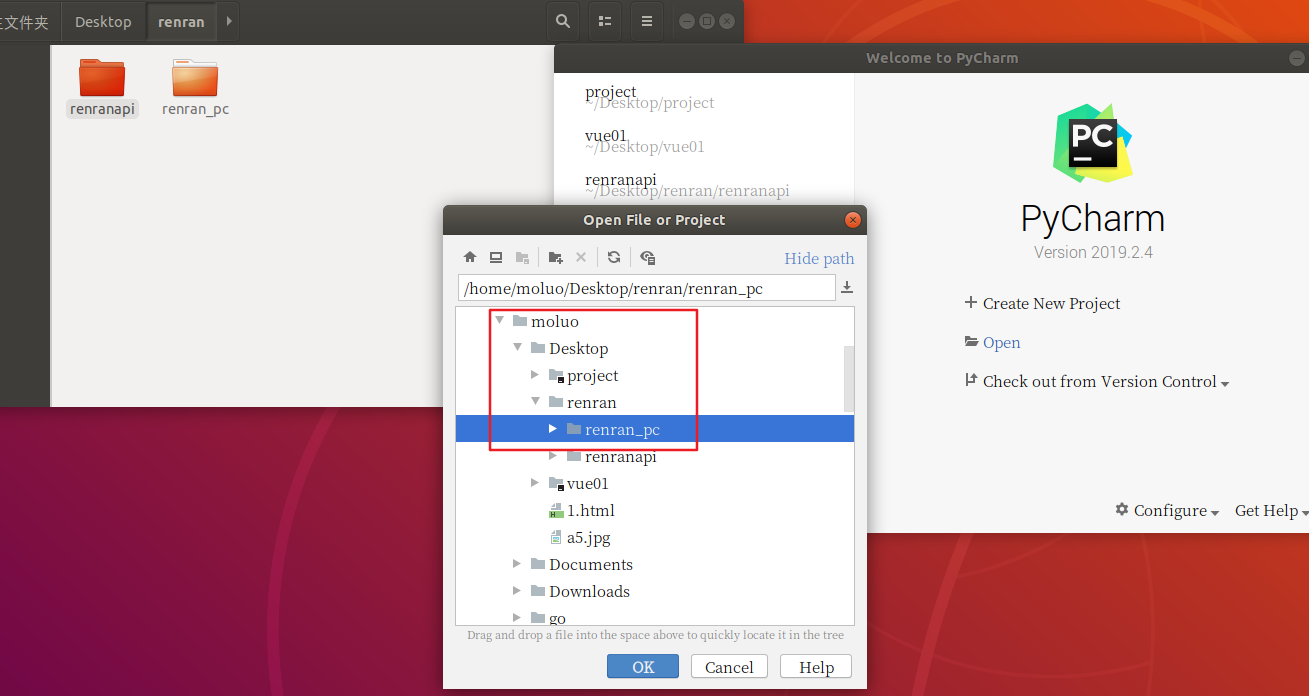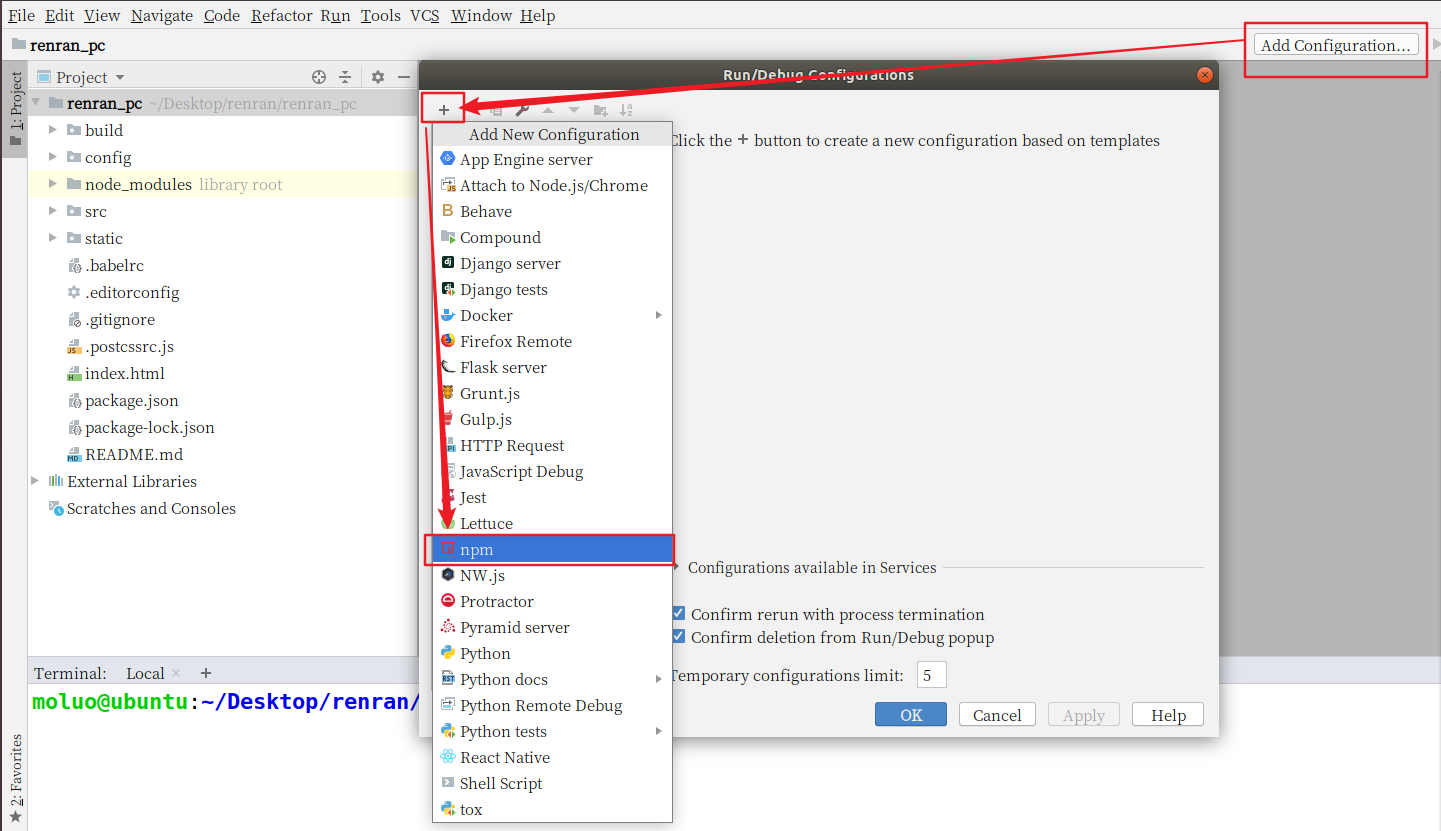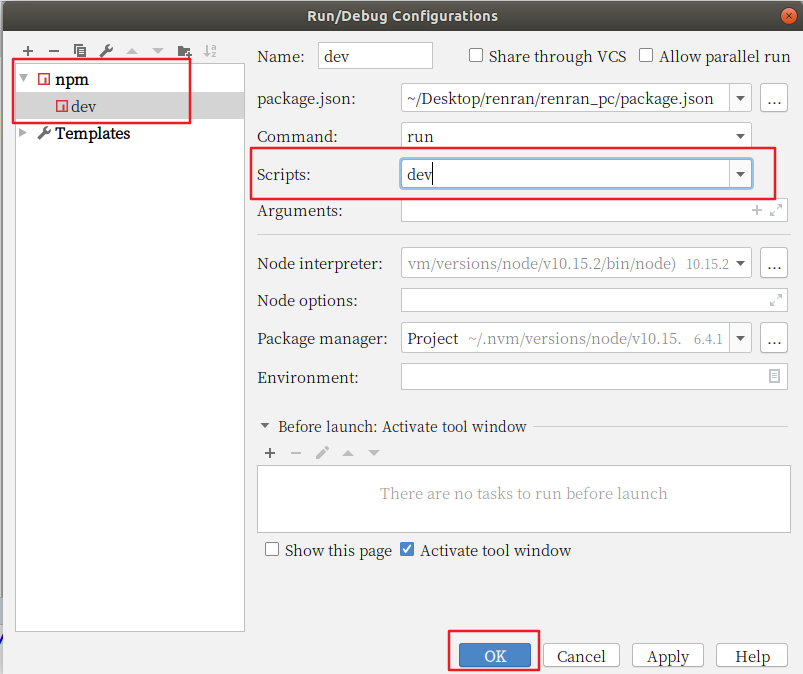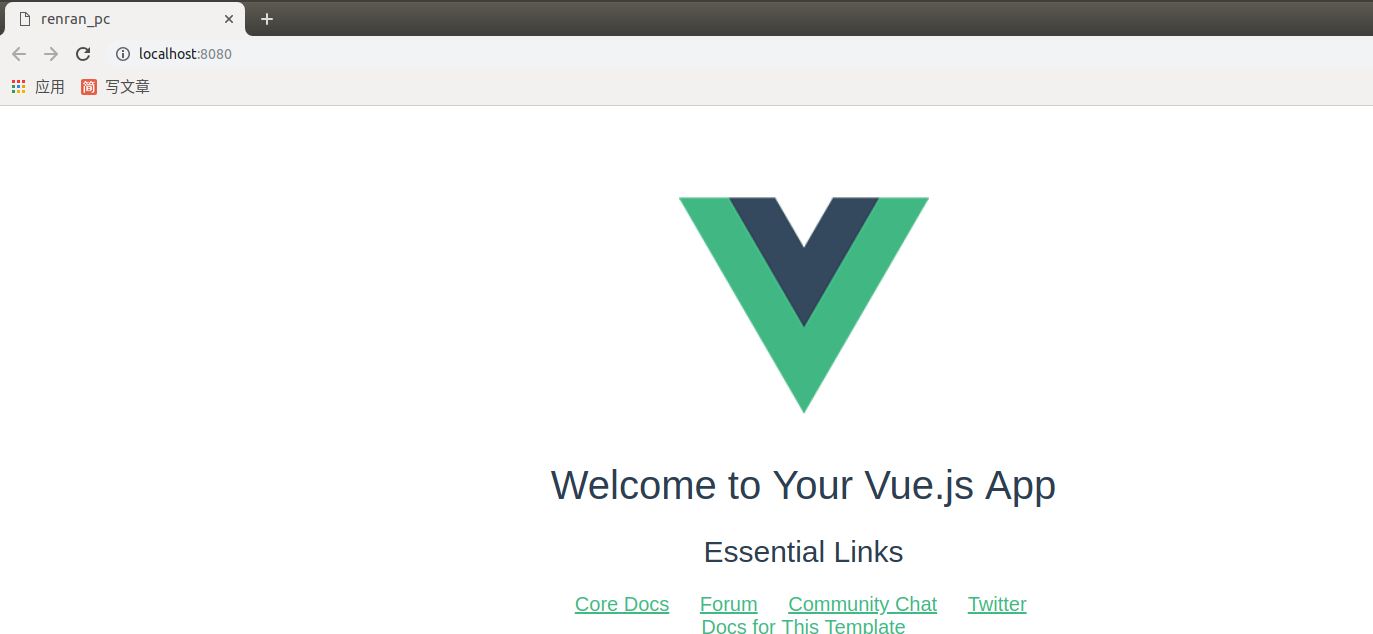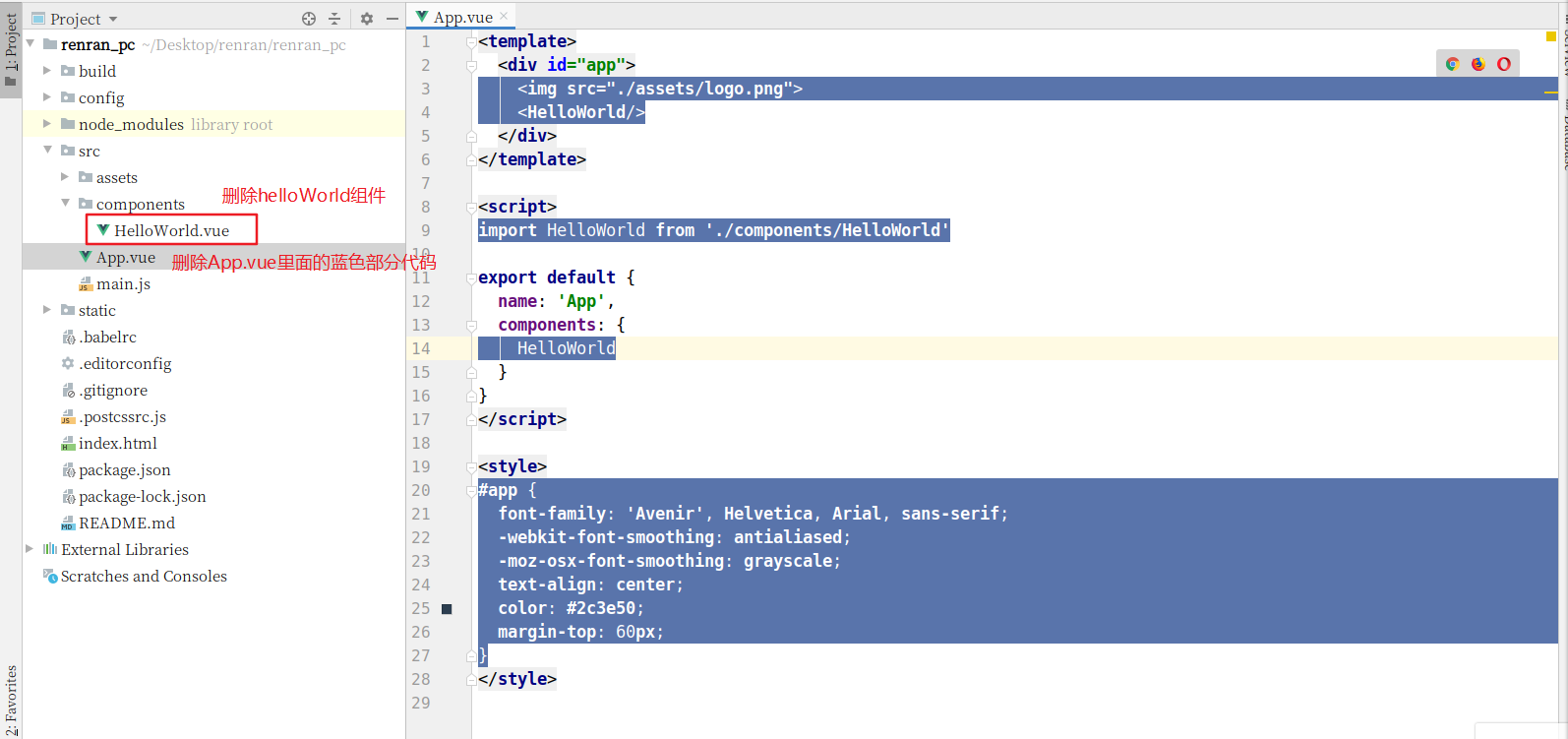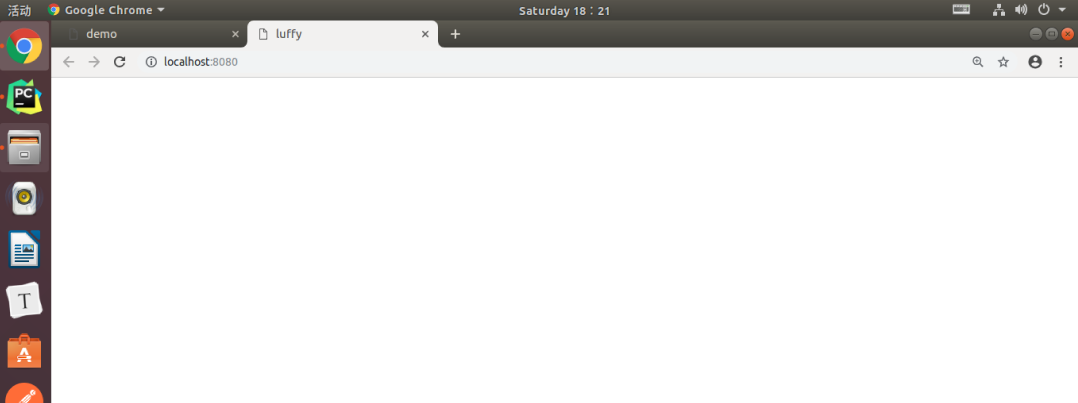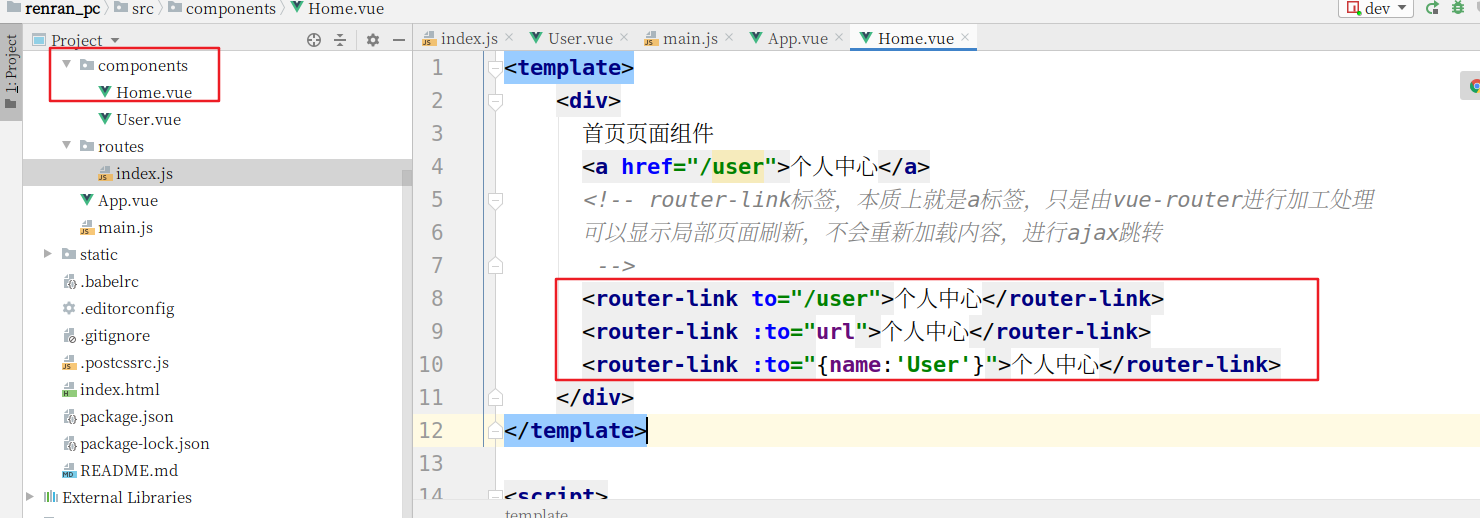客户端项目搭建 创建项目目录 1 2 cd 项目目录[荏苒资讯]vue init webpack renran
例如,我要把项目保存在桌面下的子目录renran ~/Desktop/renran,可以如下操作:
1 2 cd Desktop/renranvue init webpack renran_pc
打开项目已经,在pycharm的终端下运行vue项目,查看效果。
上面的操作步骤,等同于执行了下面这句命令。
接下来,我们根据终端上效果显示的对应地址来访问项目(如果有多个vue项目在运行,8080端口被占据了,服务器会自动改端口,所以根据自己实际在操作中看到的地址来访问。)
访问:http://localost:8080
初始化项目 清除默认的HelloWorld.vue组件和APP.vue中的默认模板代码和默认css样式
1 2 3 4 5 6 7 8 9 10 11 12 13 14 15 16 17 18 19 <template> <div id="app" > </div> </ template><script> export default { name: 'App' , components: { } } </script> <style> </ style>
接下来,我们可以查看效果了,一张白纸~
安装路由vue-router 官方文档:https://router.vuejs.org/zh/
下载安装路由组件 配置路由 初始化路由对象 在src目录下创建routes路由目录,在router目录下创建index.js路由文件
index.js路由文件中,编写初始化路由对象的代码 .
1 2 3 4 5 6 7 8 9 10 11 12 13 14 15 // 1. 引入vue和vue-router组件核心对象,并在vue中通过use注册vue-router组件 import Vue from "vue" ;import Router from "vue-router" ;Vue.use(Router); // 2. 暴露vue-router对象,并在vue-router里面编写路由,提供给main.js调用 export default new Router({ // 设置路由模式为‘history’,去掉默认的 mode: "history" , routes:[ // 路由列表 ] })
注册路由信息 打开main.js文件,把router路由规则对象注册到vue中,代码:
1 2 3 4 5 6 7 8 9 10 11 12 13 14 15 // The Vue build version to load with the `import ` command // (runtime-only or standalone) has been set in webpack.base.conf with an alias. import Vue from 'vue' import App from './App' import router from './router/index' ;Vue.config.productionTip = false /* eslint-disable no-new */ new Vue({ el: '#app' , router, components: { App }, template: '<App/>' });
在视图中显示路由对应的内容 在App.vue组件中,添加显示路由对应的内容。代码:
1 2 3 4 5 6 7 8 9 10 11 12 13 14 15 16 17 18 19 <template > <div id ="app" > <router-view /> </div > </template > <script > export default { name: 'App' , components: { } } </script > <style > </style >
注意:如果在vue创建项目的时候,设置安装vue-router,则项目会自动帮我们生成上面的router目录和index.js里面的代码,以及自动到main.js里面注册路由对象。
路由对象提供的操作 在我们安装注册了vue-router组件以后,vue-router在vue项目中会帮我们在全局范围内所有组件里面创建2个对象给我们使用:
this.$router,可用于在js代码中进行页面跳转。this.$route,可用于获取地址栏上面的url参数。
页面跳转 在vue-router提供的操作中, 进行页面跳转有2种方式:
使用<router-link to="url地址">来跳转
在<script>中使用this.$router.push(url地址)来跳转
在<script>中还可以使用this.$router.go(整数),表示跳转返回上一页或者上几页,下一个或者下几页
router-link标签 例如,我们就可以在Home.vue组件中,使用router-link跳转到User.vue组件中。
routes/index.js,代码:
1 2 3 4 5 6 7 8 9 10 11 12 13 14 15 16 17 18 19 20 21 22 23 24 25 26 27 28 29 30 31 32 33 34 // 1. 引入vue和vue-router组件核心对象,并在vue中通过use注册vue-router组件 import Vue from "vue" ;import Router from "vue-router" ;Vue.use(Router); // Router是类 // 2. 暴露vue-router对象,并在vue-router里面编写路由,提供给main.js调用 // 导入组件 // import 组件名 from "../components/组件名" import Home from "../components/Home" ;import User from "../components/User" ;export default new Router({ mode:"history" , // 路由地址的显示模式: 默认hash,表示地址栏上面出现 routes:[ // { // name:"路由名称[对应组件的name值,将来用于跳转页面]" , // path: "访问url路径" , // component: 组件名 // }, { name:"Home" , path: "/" , component: Home },{ name:"User" , path: "/user" , component: User }, ], }); // vue-router除了可以进行组件和url地址的绑定以外,还可以 // 进行不同组件的页面跳转,
Home.vue代码:
1 2 3 4 5 6 7 8 9 10 11 12 13 14 15 16 17 18 19 20 21 22 23 24 25 26 27 28 29 30 <template> <div> 首页页面组件 <a href="/user" >个人中心</a> <!-- router-link标签,本质上就是a标签,只是由vue-router进行加工处理 可以显示局部页面刷新,不会重新加载内容,进行ajax跳转 --> <router-link to="/u ser">个人中心</router-link> <router-link :to=" url">个人中心</router-link> <router-link :to=" {name :'User' }">个人中心</router-link> </div> </template> <script> export default { name: " Home", data(){ return { url: " /user", } }, methods:{ } } </script> <style scoped> </style>
this.$router.push()跳转1 2 3 4 5 6 7 8 9 10 11 12 13 14 15 16 17 18 19 20 21 22 23 24 25 26 27 28 29 30 31 32 33 34 35 36 37 38 <template> <div> 首页页面组件 <a href="/user" >个人中心</a> <!-- router-link标签,本质上就是a标签,只是由vue-router进行加工处理 可以显示局部页面刷新,不会重新加载内容,进行ajax跳转 --> <router-link to="/u ser">个人中心</router-link> <router-link :to=" url">个人中心</router-link> <router-link :to=" {name :'User' }">个人中心</router-link> <button @click=" jump">个人中心</button> </div> </template> <script> export default { name: " Home", data(){ return { url: " /user", } }, methods:{ jump(){ // 开发中可以先进行权限,登录之类的判断,然后再进行跳转 // this.$router.back(); // 返回上一页,本质上就是 location.back() // this.$router.go(-1); // 返回上一页,本质上就是 location.go() // this.$router.forward(); // 跳转到下一页,本质上就是 location.forward() this.$router.push(" /user"); // 跳转到站内的制定地址页面中,本质上就是 location.href // 注意,this.$router.push() 不能跳转到其他网站。如果真的要跳转外站,则使用location.href=" 站外地址,记得加上http: } } } </script> <style scoped> </ style>
参数传递 vue-router提供了this.$route,可以让我们接收来自其他页面的附带参数。参数有2种:
查询字符串(query string),就是地址栏上面?号后面的参数,
例如:http://localhost:8008/user?name=xiaoming&pwd=123,这里name=xiaoming&pwd=123就是查询字符串参数。
路由参数(router params),就是地址栏上面路由路径的一部分,
例如:http://localhost:8080/user/300/xiaoming,此时,300属于路由路径的一部分,这个300就是路由参数.,当然,xiaoming,或者user也可以理解是路由参数,就是看我们的页面中是否需要接收而已。
获取查询字符串 必须先有一个页面跳转发送参数。例如,在Home组件中跳转到User组件中,需要传递name和pwd查询字符串。
Home.vue代码:
1 2 3 4 5 6 7 8 9 10 11 12 13 14 15 16 17 18 19 20 21 22 23 24 25 26 27 28 29 30 31 32 33 34 35 36 37 38 39 40 41 42 43 44 <template> <div> 首页页面组件 <!-- <a href ="/user" > 个人中心</a > <!– router-link标签,本质上就是a标签,只是由vue-router进行加工处理 可以显示局部页面刷新,不会重新加载内容,进行ajax跳转 –> <router-link to="/user" >个人中心</router-link> <router-link :to="url">个人中心</ router-link> <router-link :to="{name:'User'}" >个人中心</router-link> <button @click="jump">个人中心</ button>--> <router-link :to="`/user?name=${name}&pwd=${pwd}`" >查询字符串参数</router-link> <router-link :to="'/u ser?name='+name+' &pwd='+pwd">查询字符串参数</router-link> </div> </template> <script> export default { name: "Home", data(){ return { name: "xiaoming", pwd: "123", url: "/user", } }, methods:{ jump(){ // 开发中可以先进行权限,登录之类的判断,然后再进行跳转 // this.$router.back(); // 返回上一页,本质上就是 location.back() // this.$router.go(-1); // 返回上一页,本质上就是 location.go() // this.$router.forward(); // 跳转到下一页,本质上就是 location.forward() this.$router.push("/user"); // 跳转到站内的制定地址页面中,本质上就是 location.href // 注意,this.$router.push 不能跳转到其他网站。如果真的要跳转外站,则使用location.href="站外地址,记得加上http://协议" } } } </script> <style scoped> </style>
可以下一个页面中,这里代表的就是User组件,接收来自Home组件的参数。
1 2 3 4 5 6 7 8 9 10 11 12 13 14 15 16 17 18 19 20 21 22 23 24 25 26 <template> <div> 用户中心页面组件 </div> </ template><script> export default { name: "User" , created() { } } </script> <style scoped> </ style>
获取路由参数 例如:我们用户的界面都是一样的,但是每一个用户来到自己的页面中,显示的内容肯定都是不一样的,此时,我们需要使用不同的路径来区分不同的用户。这时候,可以在路由路径中使用路由参数表示不同用户的id
例如:我们就需要设置一个route/index.js中路由信息里面,哪一段路由属于路由参数。
src/routes/index.js设置路由参数。
1 2 3 4 5 6 7 8 9 10 11 12 13 14 15 16 17 18 19 20 21 22 23 24 25 26 27 28 29 30 31 32 33 34 // 1. 引入vue和vue-router组件核心对象,并在vue中通过use注册vue-router组件 import Vue from "vue" ;import Router from "vue-router" ;Vue.use(Router); // Router是类 // 2. 暴露vue-router对象,并在vue-router里面编写路由,提供给main.js调用 // 导入组件 // import 组件名 from "../components/组件名" import Home from "../components/Home" ;import User from "../components/User" ;export default new Router({ mode:"history" , // 路由地址的显示模式: 默认hash,表示地址栏上面出现 routes:[ // { // name:"路由名称[对应组件的name值,将来用于跳转页面]" , // path: "访问url路径" , // component: 组件名 // }, { name:"Home" , path: "/" , component: Home },{ name:"User" , path: "/user/:id/img-:img_id" , component: User }, ], }); // vue-router除了可以进行组件和url地址的绑定以外,还可以 // 进行不同组件的页面跳转,
然后我们就是在Home中如果需要转到User里面。
Home.vue代码:
1 2 3 4 5 6 7 8 9 10 11 12 13 14 15 16 17 18 19 20 21 22 23 24 25 26 27 28 29 30 31 32 33 34 35 36 37 38 39 40 41 42 43 44 <template> <div> 首页页面组件 <!-- <a href ="/user" > 个人中心</a > <!– router-link标签,本质上就是a标签,只是由vue-router进行加工处理 可以显示局部页面刷新,不会重新加载内容,进行ajax跳转 –> <router-link to="/user" >个人中心</router-link> <router-link :to="url">个人中心</ router-link> <router-link :to="{name:'User'}" >个人中心</router-link> <button @click="jump">个人中心</ button>--><!-- <router-link :to ="`/user?name=${name}&pwd=${pwd}`" > 查询字符串参数</router-link > <!-- <router-link :to ="'/user?name='+name+'&pwd='+pwd" > 查询字符串参数</router-link > <router-link to="/user/100/img-10086" >路由参数</router-link> </ div></template> <script> export default { name: "Home", data(){ return { name: "xiaoming", pwd: "123", url: "/u ser", } }, methods:{ jump(){ // 开发中可以先进行权限,登录之类的判断,然后再进行跳转 // this.$router.back(); // 返回上一页,本质上就是 location.back() // this.$router.go(-1); // 返回上一页,本质上就是 location.go() // this.$router.forward(); // 跳转到下一页,本质上就是 location.forward() this.$router.push(" /user"); // 跳转到站内的制定地址页面中,本质上就是 location.href // 注意,this.$router.push 不能跳转到其他网站。如果真的要跳转外站,则使用location.href=" 站外地址,记得加上http: } } } </script> <style scoped> </ style>
User.vue,组件中可以通过this.$route.params接收路由参数。
1 2 3 4 5 6 7 8 9 10 11 12 13 14 15 16 17 18 19 20 21 22 23 24 25 26 27 28 29 30 31 32 33 34 <template> <div> 用户中心页面组件 </div> </ template><script> export default { name: "User" , created() { let id = this .$route.params.id; console .log(id); let img_id = this .$route.params.img_id; console .log(`img_id = ${img_id} ` ); } } </script> <style scoped> </ style>
ElementUI 对于前端页面布局,我们可以使用一些开源的UI框架来配合开发,常用的UI框: bootstap,H-ui框架,lay-UI框架,Amaze UI,zui框架,ElementUI.
Vue开发前端项目中,比较常用的就是ElementUI了。
ElementUI是饿了么团队开发的一个UI组件框架,这个框架提前帮我们提供了很多已经写好的通用模块,我们可以在Vue项目中引入来使用,这个框架的使用类似于我们前面学习的bootstrap框架,也就是说,我们完全可以把官方文档中的组件代码拿来就用,有定制性的内容,可以直接通过样式进行覆盖修改就可以了。
中文官网:http://element-cn.eleme.io/#/zh-CN
文档快速入门:http://element-cn.eleme.io/#/zh-CN/component/quickstart
快速安装ElementUI 项目根目录执行以下命令:
上面的命令等同于 npm install element-ui --save
执行命令效果:
配置ElementUI到项目中 在main.js中导入ElementUI,并调用。代码:
1 2 3 4 5 // elementUI 导入 import ElementUI from 'element-ui' ;import 'element-ui/lib/theme-chalk/index.css' ;// 调用插件 Vue.use(ElementUI);
成功引入了ElementUI以后,接下来我们就可以开始进入前端页面开发,首先是首页。
首页 首页采用了上下页面布局,首页是导航栏、轮播图。。。脚部等几个小模块。所以我们可以把首页作为一个组件进行开发,然后把首页的这些小模块作为单独的组件来进行开发。
创建首页组件 在src/components目录下创建文件 Home.vue
代码:
1 2 3 4 5 6 7 8 9 10 11 12 13 14 15 16 17 18 19 20 <template > <div id ="home" > 首页 </div > </template > <script > export default { name:"Home" , data(){ return { } } } </script > <style scoped > </style >
创建首页对应的路由 在router/index.js中引入Home组件,并设置Home组件作为首页路由。
代码:
1 2 3 4 5 6 7 8 9 10 11 12 13 14 15 16 17 18 19 20 21 22 23 24 import Vue from "vue" import Router from "vue-router" // 后面这里引入可以被用户访问的页面组件 import Home from "../components/Home" Vue.use(Router); export default new Router({ // 路由跳转模式,注意使用 history mode: "history" , // 路由规则 routes:[ { // name:"路由别名" , name:"Home" , // path: "路由地址" , path: "/" , // component: 组件类名, component: Home, }, ] })
